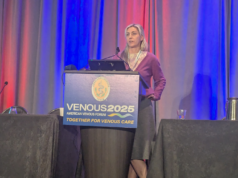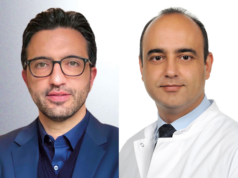
“Venous leg ulcers (VLUs) secondary to deep venous stenosis represents a distinct class of patients who require a unique treatment paradigm,” stated Abhisekh Mohapatra (University of Pittsburgh Medical Center, Pittsburgh, USA), presenting results of a multicentre retrospective study of patients presenting with VLUs—between 2013 and 2017—that favoured deep venous stenting over ablation techniques.
Speaking to attendees at the annual meeting of the American Venous Forum (VENOUS 2020; 3–6 March, Amelia Island, USA), Mohapatra begun his talk by noting that venous leg ulceration can arise from the individual incidence of deep, superficial, or perforator vein disease, or a combination thereof.
Regarding potential treatment options, the presenter commented: “Compression is the mainstay of therapy in all of these patients and is always important, regardless of the other interventions performed. When deep venous stenting is performed, it can significantly improve venous hypertension in the leg and aid in wound healing for these patients. However, multiple problems often exist, and in this situation it is not clear which veins should be treated first.”
The aim of the study, which included data for 832 patients across 11 centres in the USA, was not only to determine whether the presence of deep venous stenosis affects the wound healing trajectory of VLU patients, but also to understand which treatment strategies affect ulcer healing in those diagnosed with deep venous stenosis.
According to Mohapatra, investigators focused their attention on the cohort of patients with deep venous stenosis; baseline characteristics, anatomy of venous disease and wounds, treatments performed, and wound healing trajectories, were all studied. Furthermore, the primary outcome was successful healing of the largest index ulcer.
Of the 832 patients in the dataset, 16.1% (n=134) had stenosis in the deep venous system. The demographics of these patients showed that those with deep venous stenosis, compared to patients without, were more likely to have a history of deep venous thrombosis (47% vs. 23.6%; p<0.001), have a hypercoagulable state (27.6% vs. 10.7%; P < .001), and be receiving anticoagulation (71.6% vs 25.5%; p<0.001). Moreover, patients with deep venous stenosis were more likely, on average, to have multiple ulcers (20.2% vs 9.9%; p=0.002).
Mohapatra continued, adding that all patients with deep venous stenosis had concomitant superficial vein reflux, while 26.1% (n=35) had refluxing perforator veins. Out of the 134 deep venous stenosis patients, stenting was performed in 70.9% (n=95), truncal ablation in 44.8% (n=60) and perforator ablation in 20.9% (n=28); when both stenting and truncal ablation were performed, stenting was undertaken first in 53.5% of cases.
Turning his attention to wound healing, the speaker revealed that patients who underwent deep venous stenting healed faster than those with untreated deep venous stenosis (hazard ratio 2.46; 95% CI, 1.49̵̵̵̵̵̵-4.06; p<0.001). He also pointed to a multivariate model, which showed that deep venous stenting is the only treatment modality studied in this review that actually improved wound healing (hazard ratio 2.48, 95% CI, 1.46-4.24; p=0.001).
“There are some limitations to this type of study, which largely reflect the data source that we used. As this was a large, multicentre database, collecting data from multiple sites often requires limiting the number of variables that are collected to limit the burden of data entry, so there is some lack of granularity with respect to these patients,” Mohapatra acknowledged.
In terms of other limitations, he continued: “One of the things we wanted to know, but could not from the dataset, was whether the deep veins that were stenotic or restented were femoral or iliac veins, or the inferior vena cava. There are also different practice patterns at different institutions regarding how deep vein stenosis is diagnosed. Finally, it is unclear in some of the patients included why deep vein stenosis was diagnosed but not treated.”
Concluding, Mohapatra confirmed that stenting improved wound healing rates, whereas ablation of pathologic superficial or perforator veins did not. Looking ahead, he posited that routine imaging of the iliocaval segment may help the clinician to pursue early deep vein stenting to maximise ulcer healing and avoid unhelpful truncal and perforator interventions.









